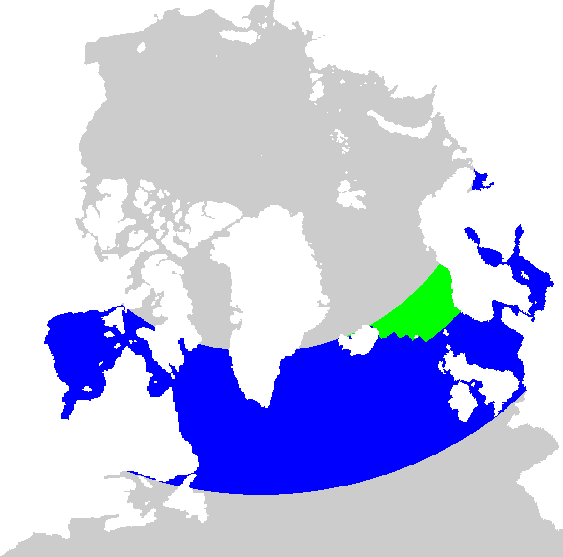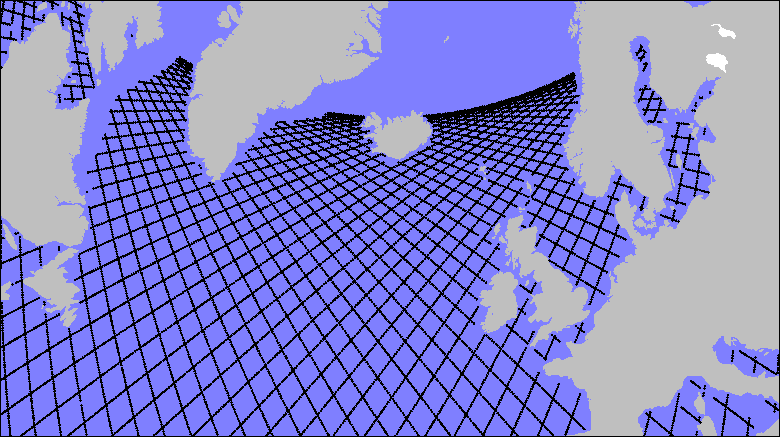MyOcean Arctic MFC: V1 Validation of sea level anomalies
Validation based on satellite data from Jason-2
Validation of the MyOcean Arctic MFC results for sea level anomalies is performed using altimeter data from the the Jason-2 satellite. These data have been corrected for a number of processes, including removal of the tidal signal and correction for the inverse barometer effect. Note that altimeter data from Jason-2 are assimilated in the EnKF used in the TOPAZ model. However, we use an updated product for this validation, which may have improvements due to an updated computation of the inverse barometer, and more precise knowledge of the satellite orbit.
Each Jason-2 cycle is diveded into 254 tracks, half of which are ascending and half are descending (more below). The instrument's sampling frequency is approximately 0.927 Hz, corresponding to a horizontal separation of about 18.5 km along the track.
Jason-2 data are available from ftp.aviso.oceanobs.com (ftp server, password required), operated by Coriolis.
| February 2011
02-09 02-16 02-23 |
March 2011
03-02 03-09 03-16 03-23 03-30 |
April 2011
04-06 04-13 04-20 04-27 |
May 2011
05-04 05-11 05-18 05-25 |
June 2011
06-01 06-08 06-15 06-22 06-29 |
July 2011
07-06 07-13 07-20 07-27 |
August 2011
08-03 08-10 08-17 08-24 08-31 |
September 2011
09-07 09-14 09-21 09-28 |
October 2011
10-05 10-12 10-19 10-26 |
November 2011
11-02 11-09 11-16 11-23 11-30 |
December 2011
12-07 12-14 12-21 12-28 |
| January 2012
01-04 01-11 01-18 01-25 |
February 2012
02-01 |
Regions

|
The ocean circulation model used in myOcean's Arctic MFC covers the Arctic Ocean, the North Atlantic Ocean and adjacent ocean regions. The northern part is depicted in the figure to the left. Validation of sea level anomalies from model results are performed for two domains:
The validation is performed using processed data from the altimeter onboard the Jason-2 satellite. The region covered by the satellite is limited by the 66° 8' parallell, as indicated in the figure below. This limit in the poleward extent of data significantly reduces the extent of the key domain for MyOcean's Arctic Monitoring and Forecasting Centre. However, using Jason-2 data almost eliminates possible problems due to the presence of sea ice at higher latitudes. The alternative observations which also cover higher latitudes, is the altimeter data from Envisat. Like its predecessors TOPEX/Poseidon and Jason-1, Jason-2 has an orbital period of 6754 s (1:52:34). The full surface trace is constituted by 254 tracks, with one ascending track and one descending track in each orbit. Tracks in the region relevant for the Arctic Monitoring and Forecasting Centre is shown by the black curves below. The repeat period then becomes approximately 10 days. Using tide gauge data from around the world as reference, validation of Jason-2 altimetry data has revealed a standard deviation of the sea level anomaly of approxiately 4 cm, see this report for details. |
Processing
|
The RMS difference between model sea level and observations is calculated track-by-track. Before the root-mean-square differences are computed, the following processing is performed:
|

|
TOPAZ
The model results are produced with the TOPAZ ocean data assimilation model system. Presently, TOPAZ is run weekly with data assimillation one week prior to the bulletin date, followed by a one-week 100 member ensemble simulation ending on the bulletin date, and finally a 10 day deterministic forecast. TOPAZ was developed and is maintained by the Nansen Center.
TOPAZ results are available as aggregated, best estimates, and as a list of Bulletin dates with separate forecasts.
